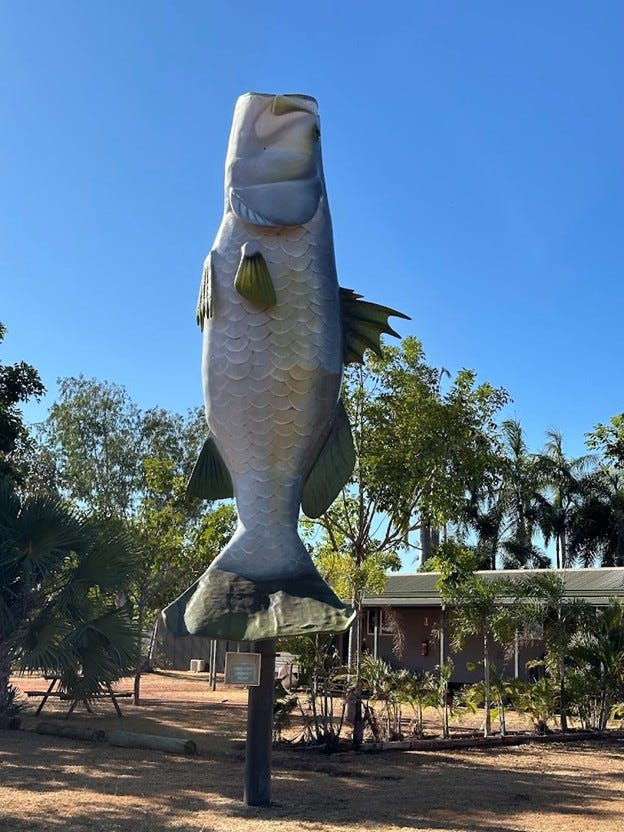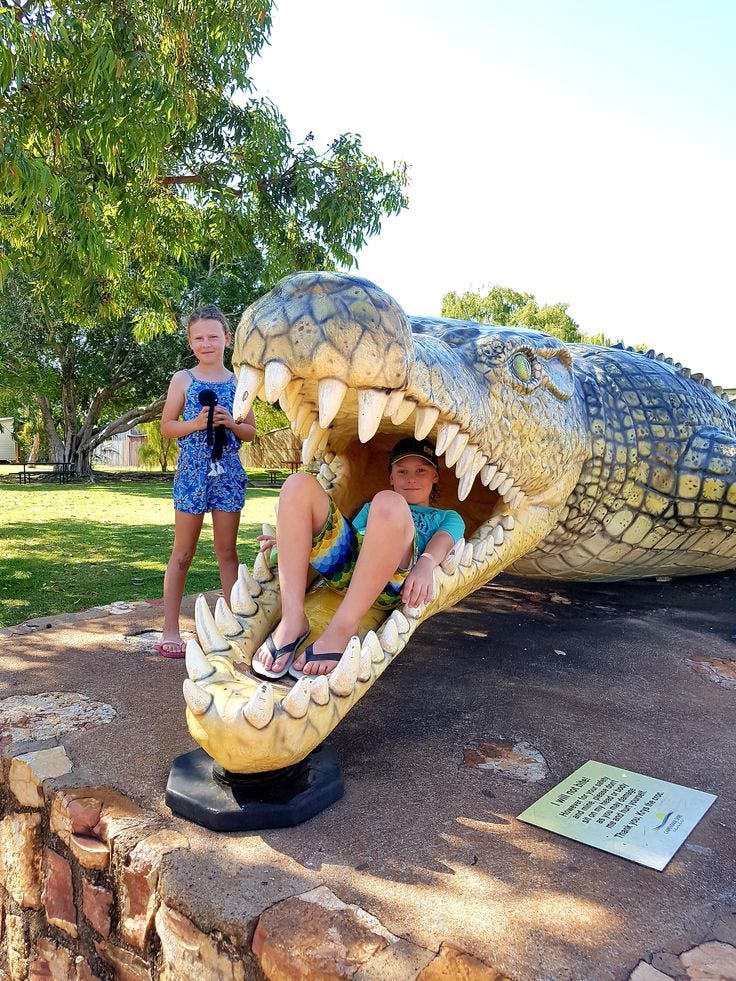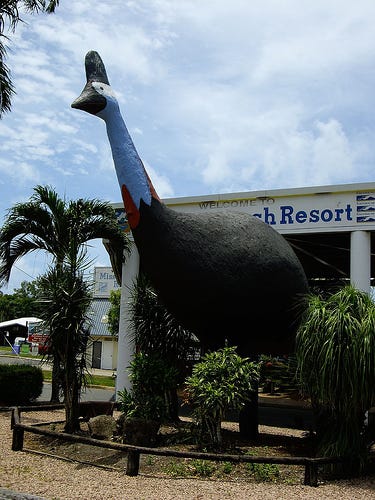Travelling – The Big Australian Road Trip – Queensland # 1
“That's not a knife. That's a knife” says Mick Dundee (Paul Hogan) in the 1986 movie Crocodile Dundee. It was BIG!
"Going big or going home" is another saying, and in Australia, we like to promote 'big things'. So, let's plan our round trip state by state around Australia and explore all the big things.
Apparently, "big things" in Australia dates to the 1960s, and South Australia had the first.
But let's begin with Queensland, my home state.
Here are some facts about Queensland to consider before we pack the car and get on the road. What music do you think we should include?
As the name perfectly suggests, they named it Queensland to honour Queen Victoria.
On 6 June 1859, Queensland separated from the colony of New South Wales when Queen Victoria signed papers allowing Queensland to become an independent colony (now known as Queensland Day).
In 1867, James Nash discovered gold on the Mary River. This was the beginning of a gold rush, which greatly shaped Queensland's economy and population.
Queensland is Australia's second-largest state (behind Western Australia), with a total area of 1,730,648 km2.
Queensland is often called the 'Sunshine State'; its people are sometimes affectionately known as 'banana benders'.
Four Australian Prime Ministers came from Queensland: Andrew Fisher, Arthur Fadden, Francis Forde and Kevin Rudd.
The first Female Governor General was born in Queensland, Quentin Bryce. More on this will come in my female first series.
Queensland may be best known for its sparkling coastline and idyllic islands dotting the wondrous Great Barrier Reef. Still, the state also features rugged outback landscapes and ancient rainforests, home to some of the world's most unusual animals.
Foods – mangoes, bananas and sweet, sun-ripened pineapples, reef fish and wild-caught prawn
Queensland's calling. Seven times bigger than Great Britain.
We've got the car loaded, our music, and our trusty map. So, we'll start up north and travel south. After Queensland is done, we can move into New South Wales and eventually do a lap around Australia.
Are you ready….we are on the road again…maybe we can change the words and say I've been everywhere in Queensland, man?
Click on the links below for relevance in past Newsletters.
Way up North, Normanton is pretty isolated and sparsely populated. We will visit Normanton, home of the Big Barra, which is 6 metres long and located here.
The Big Barramundi is located in Normanton, a small cattle town in the Gulf Country region of northwest Queensland, Australia, just south of the Gulf of Carpentaria, on the Norman River. The town's population is estimated to be around 1,100. More than half are Indigenous Australians. The town is one terminus of the isolated Normanton – Croydon Railway, which was built during gold rush days in the 1890s. The Gulf Lander motor train operates once a week. Barramundi and salmon may also be caught in the Norman river.
Normanton is the administrative centre of the Shire of Carpentaria.
Did you know?
Normanton is known as the Barramundi Capital of the North. Barramundi is the most common fish species in the Norman River.
Among Normanton's most notable features is a statue of an 8.64 m long saltwater crocodile named Krys, the largest ever taken. Krystina Pawlowska shot it in July 1957 in the Norman River.
Admire this impressive beast from dry land and pray you never face a real one this size in the wild during your travels! This is crocodile Country!
How are you going so far? Did you get some prawns and cook them on a barbecue in true Ozzie style? They are not shrimp; they are prawns, but they are big and mouth-wateringly delicious.
I remember when I was little, my Mum and Dad would drag a net on a beach not far from Sarina (it's on our trip) and get sack bags full of prawns that Dad would cook in the copper and give away. I have often remarked that at today's prices, they could have retired on the money they could have made, especially as they were so fresh, not frozen like the ones in the supermarkets today.
Now your tummy is full and we seen to two BIG THINGS in one location, we need to get on the road again and travel over 600 km to Mission Beach.
Our mission this time is the Big Cassowary, located in the local shopping centre. It stands 5 metres tall and is known for its red and blue colourings.
The area around Mission Beach is home to one of Australia's highest concentrations of endangered cassowary. These large flightless birds can be spotted walking through fields and gardens and occasionally swimming across rivers.
Watch out for the warning signs on the streets – slow down cassowary crossings.
Cassowaries and ratites are considered pretty close living relatives of certain avian dinosaurs.
This large flightless bird was an important traditional food source for our rainforest people. To this day, the Gunduy holds great significance to rainforest Aboriginal peoples.
The cassowary is Australia's heaviest bird, weighing up to 76kg! At 1.8m in height, it is second only to the Emus (which can reach 2m).
If you encounter a southern cassowary, back away slowly, put something like a tree or a backpack between you and the bird, and let it go on its way.
Cassowaries are shy and usually hard to spot, at least in their natural rainforest habitats. They are not overly aggressive, and attacks are rare. But they can do a lot of damage if they are provoked or angered.
Natural predators of cassowaries include crocodiles, pythons, dingoes, and quolls. However, the effects of these animals are minimal when compared with threats introduced over the last two hundred years. Pigs are a big problem.
Mission Beach - No traffic lights, chain stores, or crowds. Sitting quietly between two World Heritage areas, a tropical paradise filled to the brim with all the natural beauty and adventure you could ever hope for. 1
After breakfast, it's time to change pace and get among the green of nearby Djiru National Park, home to some of the last remaining lowland rainforest and rare Licuala fan palms. Take the 1.5km Lacey Creek Walk to discover a hidden gem: a soak in crystal clear waters – and keep your eyes peeled for cassowaries.
Join Raging Thunder Adventures for whitewater rafting or Wildside for sports rafting: either way, be prepared to get wet as you tackle the mighty Tully River. Broken up into sections of whitewater and calm river passages, the experience is both thrilling and peaceful. When you're not battling rapids head-on, you'll find yourself in awe of your surroundings, the water's edge fringed by some of the oldest rainforests in the world.
Note: white water rafting may not be available during the drier winter months, so check in with the individual operators before you go. Explore the outer Great Barrier Reef.
Check out Newsletter heart racing moments - me white water rafting on the Tully River
Me White Water Rafting Tully River
Take the FastCat ferry service by QuickCoast and spend a little time on Dunk Island.
Europeans initially named the district Clump Point. In time, it slowly became Mission Beach through common usage due to the brief presence of the Hull River Aboriginal Settlement (1914 – 1918), which was referred to as a 'mission' in error.
Did you know? Series 2 and 3 of Escape from Scorpion Island were filmed at Mission Beach. The Australian television series Sea Patrol has filmed five of its series in the waters of the Mission Beach area. The 2022 Netflix series Irreverent was filmed in and around Mission Beach and its church.
We have visited the Gulf Country and ended up on the beautiful white sandy, palm-lined, crystal-clear azure waters of Mission Beach. It is time to take a breather, as we have covered over 600 km.
What is next? What secrets in our BIG trip will Tully unveil?
I hope you took photos in front of the BIG BARRA, BIG CROCODILE and the Big CASSOWARY - just like I did with the Pandas. (see below)
Issue #32
I can't wait to get on the road again as we move south in the Sunshine State, smiling, singing, and snapping the sights. I hope you are keen, too!
What music have you been singing?
Queensland Tourism - How to spend 72 hours in Mission Beach







